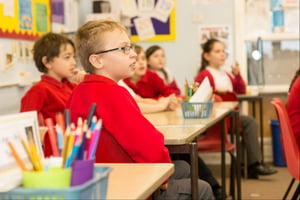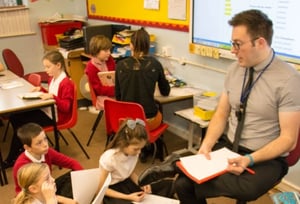What is a flipped classroom?
A flipped classroom approach is where study material is given to students for the purpose of starting study at home, then using the classroom environment to expand on the learning with their teacher.
Flipped learning can benefit your students and help accelerate their progress. So, we've found 8 simple tips that might help you flip your classroom.
8 tips to get you started with flipped learning
1. Begin with the end in mind
First, decide on the lesson’s core objectives; creating your video and any class activities will be much easier if you are consistently focused on the goal of the lesson.
2. Be honest
Because flipping your classroom turns the traditional learning experience on its head, be upfront with your students about what is going to happen, what you expect from them and the idea behind a flipped classroom.
3. Create a ‘need to know’
The learner won’t necessarily watch the video in their own time unless they feel compelled to. Giving your students a transparent and embedded reason to know the content can help with this.
4. Don’t presume anything
Be clear and concise in your instructions, even clearer than you think you need to be. Never assume the learner will understand and don’t leave anything to guessing in case of misinterpretation.
5. Get parents on board
Because flipped learning takes a learner-centered approach, it is important to have your students’ parents on side to feel safe in the knowledge that your learners will have the resources, support and time they need to learn outside of class time.
6. Create suitable activities for the learner
Keep the learning outcomes at the forefront of your mind and develop activities for class time that will achieve the lesson’s goals and reinforce student learning.
7. Keep the learning manageable
Try not to record extensive videos that will take your students ages to watch as they’ll be less likely to, even if you have provided them with a convincing ‘need to know’. Instead, make sure the content you provide feels doable to students.
8. Make the most of technology
The technology you use needs to support easy creation of the material and allow for easy access by the students so consider it carefully. There are a number of things to consider, such as whether you will ask all students to watch your video or differentiate with choice.
Why use flipped learning?
A flipped classroom takes the ‘traditional learning experience’ and turns it inside out.
Rather than using classroom time to teach students, they are asked to watch a lecture that the teacher has recorded before the lesson, for example.
Classroom time is then used as an opportunity for students to put their learning into practice by engaging in discussions and completing activities.
The benefits of a flipped classroom:
- Makes the classroom a more interactive learning environment
- Saves teacher time covering the basic information
- Allows students to learn at their own pace
- Helps the teacher tailor learning to each individual student’s needs
- Reduces the challenge of getting students engaged into the topic - students take in the foundation knowledge in their own time and at their own pace
- Student develop independent learning skills
- Absent students don't fall too far behind
- Teacher can reuse the content
- It's an efficient use of class time
- It promotes student centered learning and collaboration
- Increases student-teacher interaction
Do you have any experience of flipped learning? Got any tips of your own to share?



Leave a comment:
Get blog notifications
Keep up to date with our latest professional learning blogs.